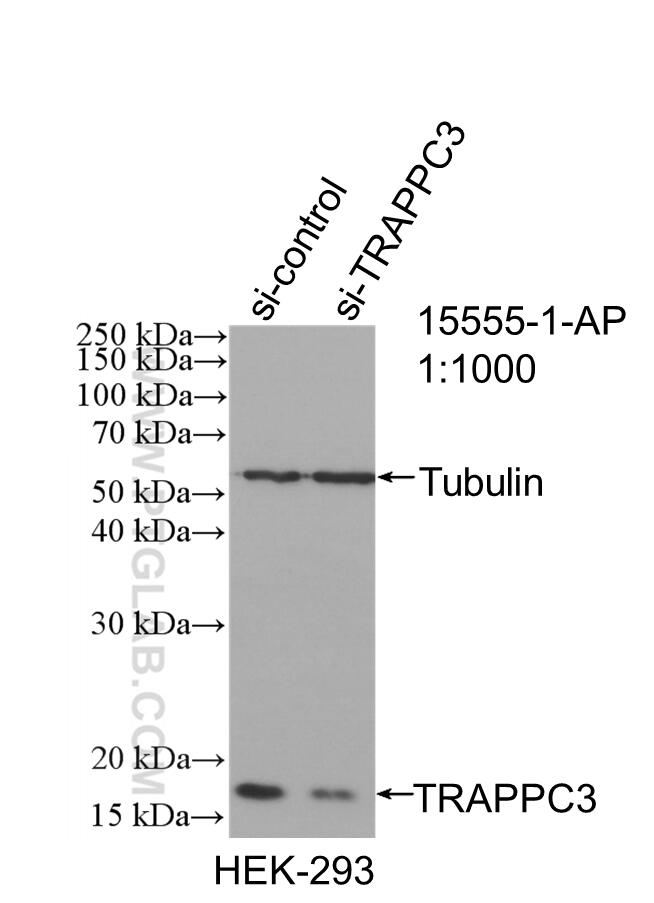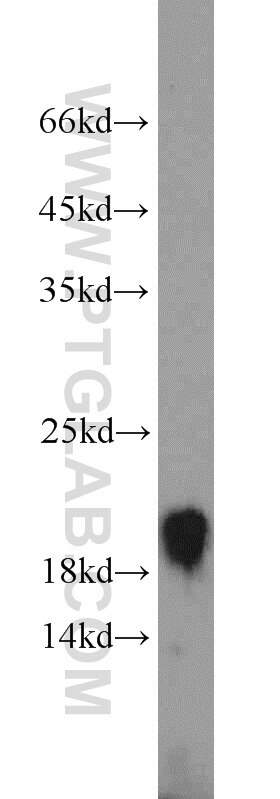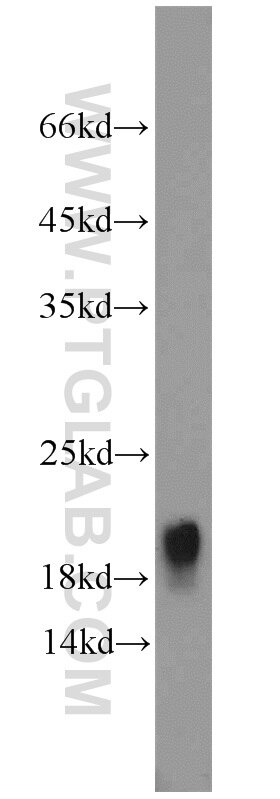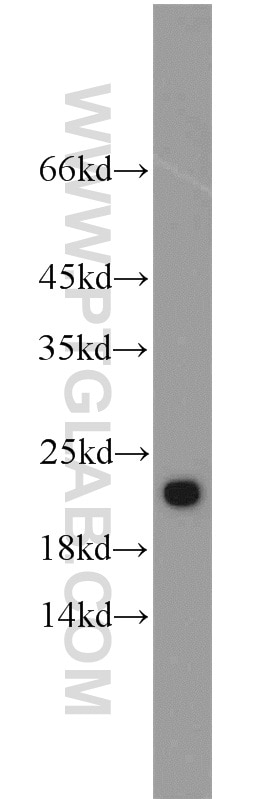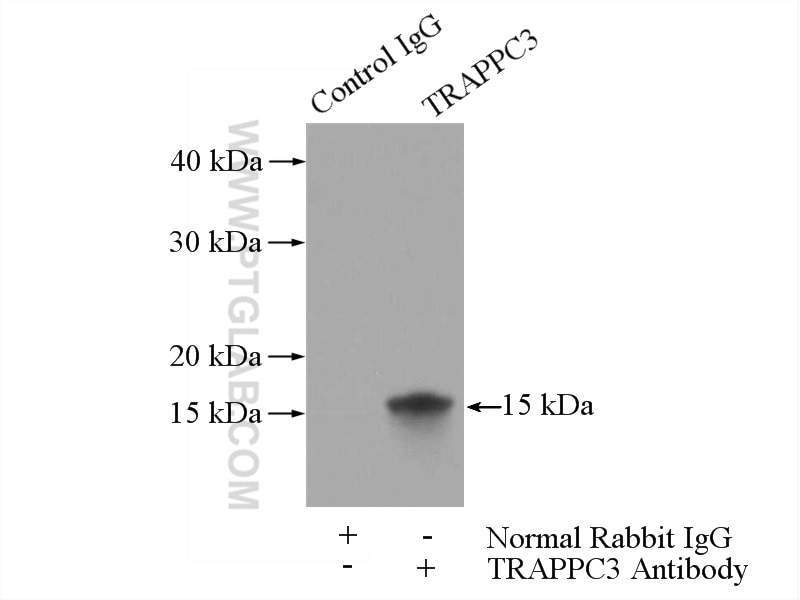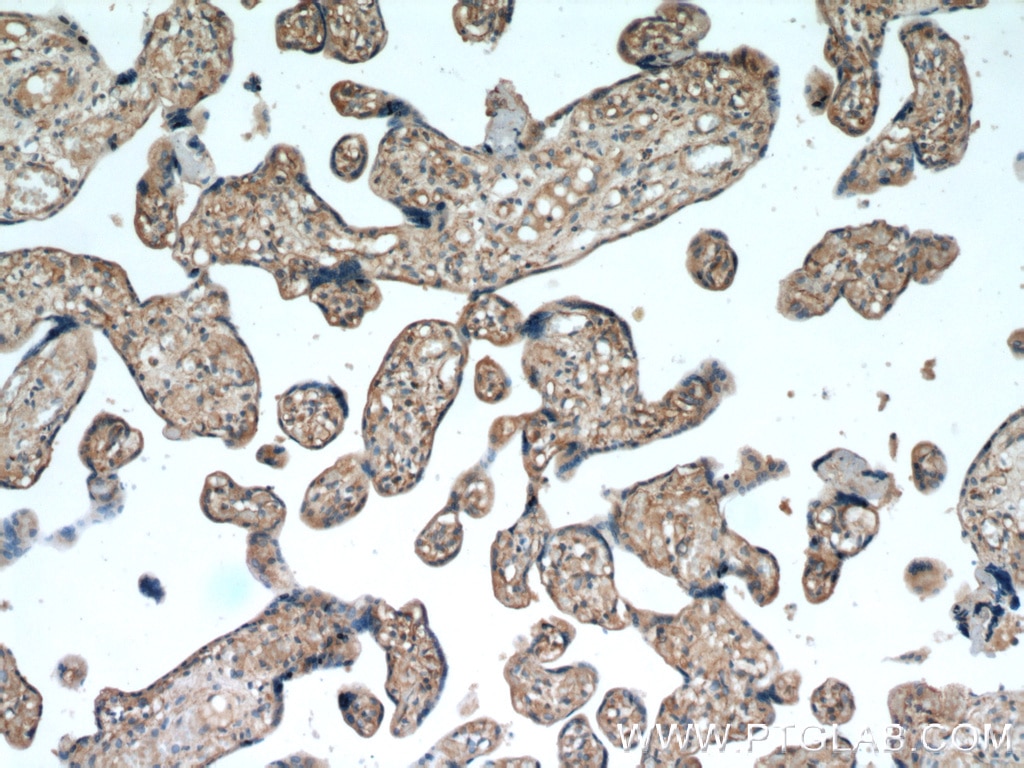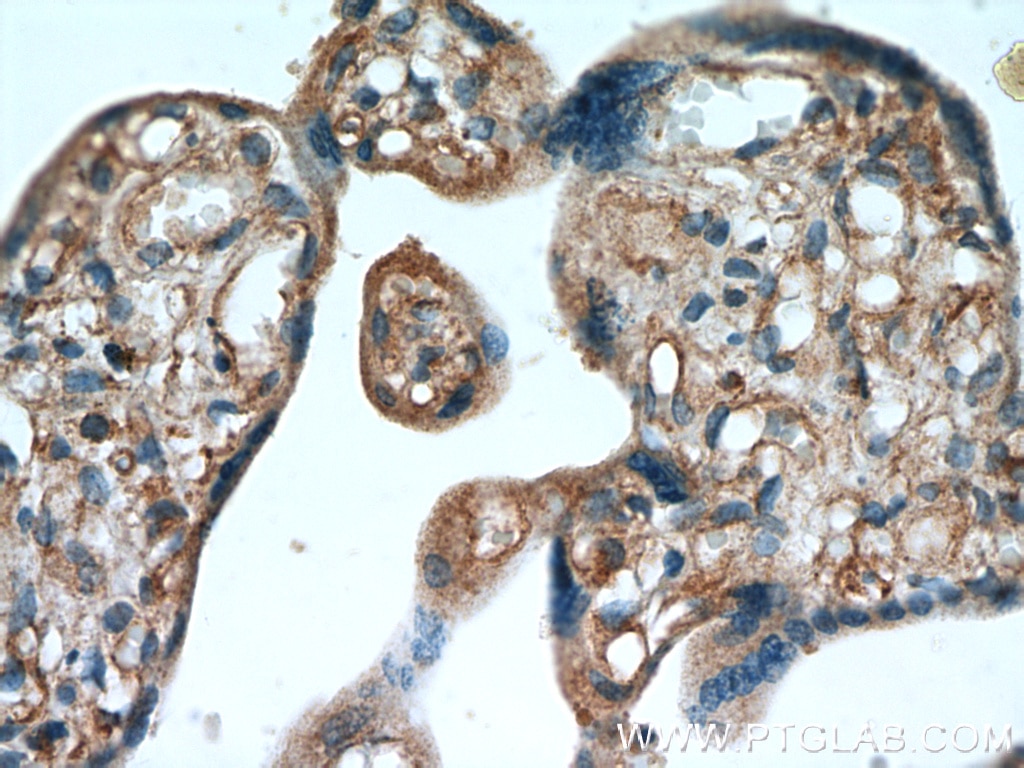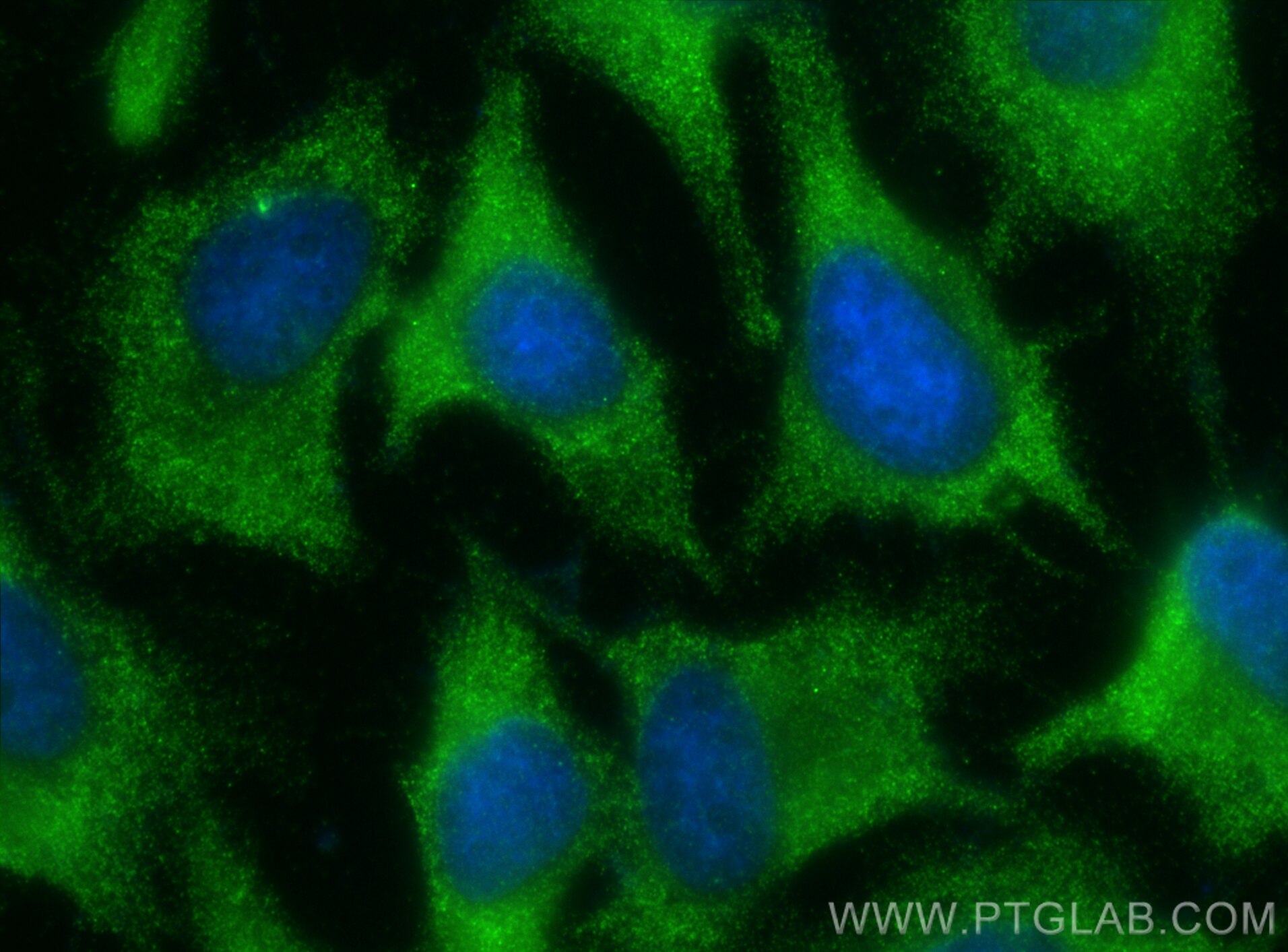- Featured Product
- KD/KO Validated
TRAPPC3 Polyklonaler Antikörper
TRAPPC3 Polyklonal Antikörper für WB, IHC, IF/ICC, IP, ELISA
Wirt / Isotyp
Kaninchen / IgG
Getestete Reaktivität
human, Maus
Anwendung
WB, IHC, IF/ICC, IP, ELISA
Konjugation
Unkonjugiert
Kat-Nr. : 15555-1-AP
Synonyme
Geprüfte Anwendungen
| Erfolgreiche Detektion in WB | Mauslebergewebe, HEK-293-Zellen, Maus-Dünndarmgewebe, PC-3-Zellen |
| Erfolgreiche IP | Mauslebergewebe |
| Erfolgreiche Detektion in IHC | humanes Plazenta-Gewebe Hinweis: Antigendemaskierung mit TE-Puffer pH 9,0 empfohlen. (*) Wahlweise kann die Antigendemaskierung auch mit Citratpuffer pH 6,0 erfolgen. |
| Erfolgreiche Detektion in IF/ICC | HeLa-Zellen |
Empfohlene Verdünnung
| Anwendung | Verdünnung |
|---|---|
| Western Blot (WB) | WB : 1:500-1:1000 |
| Immunpräzipitation (IP) | IP : 0.5-4.0 ug for 1.0-3.0 mg of total protein lysate |
| Immunhistochemie (IHC) | IHC : 1:20-1:200 |
| Immunfluoreszenz (IF)/ICC | IF/ICC : 1:200-1:800 |
| It is recommended that this reagent should be titrated in each testing system to obtain optimal results. | |
| Sample-dependent, check data in validation data gallery | |
Veröffentlichte Anwendungen
| WB | See 7 publications below |
Produktinformation
15555-1-AP bindet in WB, IHC, IF/ICC, IP, ELISA TRAPPC3 und zeigt Reaktivität mit human, Maus
| Getestete Reaktivität | human, Maus |
| In Publikationen genannte Reaktivität | human, Maus |
| Wirt / Isotyp | Kaninchen / IgG |
| Klonalität | Polyklonal |
| Typ | Antikörper |
| Immunogen | TRAPPC3 fusion protein Ag7924 |
| Vollständiger Name | trafficking protein particle complex 3 |
| Berechnetes Molekulargewicht | 20 kDa |
| Beobachtetes Molekulargewicht | 20-22 kDa |
| GenBank-Zugangsnummer | BC007662 |
| Gene symbol | TRAPPC3 |
| Gene ID (NCBI) | 27095 |
| Konjugation | Unkonjugiert |
| Form | Liquid |
| Reinigungsmethode | Antigen-Affinitätsreinigung |
| Lagerungspuffer | PBS with 0.02% sodium azide and 50% glycerol |
| Lagerungsbedingungen | Bei -20°C lagern. Nach dem Versand ein Jahr lang stabil Aliquotieren ist bei -20oC Lagerung nicht notwendig. 20ul Größen enthalten 0,1% BSA. |
Hintergrundinformationen
TRAPPC3 (trafficking protein particle complex 3, also known as Bet3) is a component of TRAPP, a complex involved in the tethering of transport vesicles to the cis-Golgi membrane. There are three TRAPP complexes identified in yeast with distinct roles: TRAPPI in ER-Golgi traffic, TRAPPII in intra-Golgi and endosome-Golgi traffic, and TRAPPIII in autophagy. Recently it has been proposed that at least two complexes exist in mammals. TRAPPC3 is the most conserved subunit of TRAPP and has been used to precipitate the intact tethering complex both from yeast and from human cells. It has also been reported that TRAPPC3 is required for Rabin8 centrosome trafficking and ciliogenesis. Expressed ubiquitously, TRAPPC3 protein is present in both membrane-bound and cytosolic forms. This antibody recognizes the endogenous 20-22 kDa TRAPPC3 in multiple cell lines. (15728249, 21273506, 23394947)
Protokolle
| PRODUKTSPEZIFISCHE PROTOKOLLE | |
|---|---|
| WB protocol for TRAPPC3 antibody 15555-1-AP | Protokoll herunterladen |
| IHC protocol for TRAPPC3 antibody 15555-1-AP | Protokoll herunterladenl |
| IF protocol for TRAPPC3 antibody 15555-1-AP | Protokoll herunterladen |
| IP protocol for TRAPPC3 antibody 15555-1-AP | Protokoll herunterladen |
| STANDARD-PROTOKOLLE | |
|---|---|
| Klicken Sie hier, um unsere Standardprotokolle anzuzeigen |
Publikationen
| Species | Application | Title |
|---|---|---|
Cell A systematic mammalian genetic interaction map reveals pathways underlying ricin susceptibility. | ||
Proc Natl Acad Sci U S A Primary cilia membrane assembly is initiated by Rab11 and transport protein particle II (TRAPPII) complex-dependent trafficking of Rabin8 to the centrosome. | ||
Int J Biol Sci Defective neurite elongation and branching in Nibp/Trappc9 deficient zebrafish and mice | ||
J Biol Chem The C7orf43/TRAPPC14 component links the TRAPPII complex to RABIN8 for preciliary vesicle tethering at the mother centriole during ciliogenesis. | ||
Signal Transduct Target Ther RING finger 138 deregulation distorts NF-кB signaling and facilities colitis switch to aggressive malignancy. | ||
Metabolites Integrating TCGA and Single-Cell Sequencing Data for Hepatocellular Carcinoma: A Novel Glycosylation (GLY)/Tumor Microenvironment (TME) Classifier to Predict Prognosis and Immunotherapy Response |
